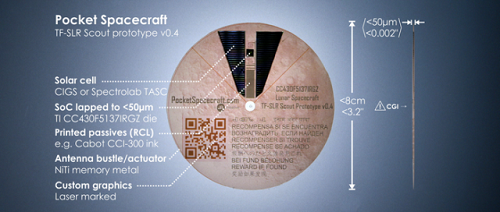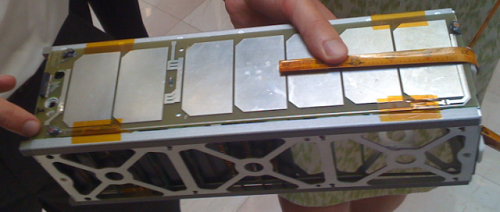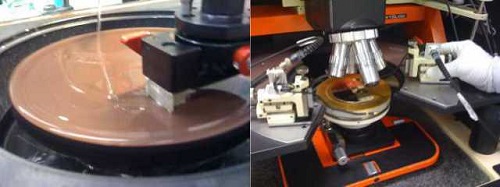Last week we looked at Mason Peck’s ideas on ‘Sprites,’ tiny spacecraft the size of computer chips that could be sent in swarms to targets near and far. I was particularly interested in Peck’s idea of using Jupiter as a massive particle accelerator, bringing huge numbers of Sprites up to speeds in the range of hundreds of kilometers per second. Growing out of Clifford Singer’s insights in the 1970s and given onboard intelligence by Gerald Nordley, the idea of ‘smart pellets’ thus moves beyond a propulsion method to become a fleet of networked space probes.
Perhaps one day we’ll be able to use the tools of nanotechnology to create highly intelligent vehicles of extremely small size, rendering the propulsion problem a bit more tractable. But until we’re at that level, it’s fascinating to see the groundwork being laid in work like Peck’s. Today I want to talk about another experiment with space vehicles that are smaller than a compact disc and as thin as a piece of paper. Pocket Spacecraft are being developed for launch in a CubeSat for a range of potential missions in an energetic attempt at space crowdsourcing.
We’ve already seen crowdsourcing at work in projects like KickSat, which is still in the works in the capable hands of Zachary Manchester at Cornell despite an initial setback last April. KickSat would have deployed a large number of Sprites for early testing, as will, presumably, the follow-up KickSat-2. Some members of the KickSat team have also gone on to work on Pocket Spacecraft, a project that has tapped the skills of volunteers from over twenty countries, and one that has played a major role in conferences like the Interplanetary CubeSat Workshop (MIT) and a Caltech event called Small Satellites: A Revolution in Space Science.
So what are Pocket Spacecraft? The image below gives you the gist of a spacecraft small enough to fit in your pocket, essentially a disk made out of the same material you find in flexible circuit boards. The polyimide disk is ringed by a nickel titanium hoop that contains memory and doubles as an antenna for the diminutive vehicle. Let me quote from the Pocket Spacecraft site to continue the description:
Solar cells, a thinned commercial off the shelf system-on-a-chip die (ground down with diamond sand paper) and support components, sensors and instruments are bonded or printed on the polyimide and protected with a conformal coating resulting in a spacecraft with an average thickness less than one twentieth of a millimetre (two thousandths of an inch), and a mass much less than a gram (a thirtieth of an ounce).

Image: Thin-Film Scout prototype consisting of a polyimide substrate, bonded solar cells and thinned die, printed passive components, antennas and images. Credit: Pocket Spacecraft.
The upshot is that Pocket Spacecraft can be packed tightly, thousands to a single CubeSat ‘mothership.’ We’ve seen that CubeSats are destined to be true workhorses for inexpensive space missions, a fact underlined by recent NASA studies on CubeSats in interplanetary space. In February of 2013, NASA selected 24 small satellites to fly as auxiliary payloads on rockets planned for launch in the next two years, the CubeSats being proposed coming not only from NASA centers (three from JPL) but educational institutions and non-profit organizations.
We’ve also seen that The Planetary Society has been engaged in a lengthy study of solar sails, with plans for its LightSail-1 to be deployed from a CubeSat. Potentially, the tools are all here to allow us to fly CubeSats with different instrument configurations to a wide range of targets in the Solar System using solar sails for propulsion. The Pocket Spacecraft team also speaks about another option, a system based on electrolysis, using solar power to break down liquid fuel. Its CubeSats are radiation hardened and contain the subsystems needed to communicate with Earth as well as to release and photograph the numerous CD-sized Pocket Spacecraft.

Image: An engineering model of a 3U CubeSat, the largest most commonly launched CubeSat format. Credit: Pocket Spacecraft.
Call them ‘Scouts,’ as the Pocket Spacecraft team does. The Scouts house integrated optical and radio transceivers and sensors including an accelerometer, gyroscope, temperature sensor, and single pixel optical sensor. Using online tools including smartphone apps, contributors to the project can take a role in personalizing an individual Scout and, using a Web browser, can participate in science experiments. The more technically inclined can use Arduino tools to run their own software on Scouts, backed by a Web-based integrated development environment.
So the crowdsourced side of this project is engaging because it’s not just a matter of contributing money, but of participating in an active way with a space mission. Some Scouts are to be released from Earth orbit to test their ability to re-enter the atmosphere, taken measurements of the Earth’s thermosphere along the way. Others will be flown on a low energy transfer orbit to the Moon for release and landing on the surface. The attempt is to show that a collaboration of private citizens operating on a shoestring budget can design and build spacecraft that can travel not just into orbit but to the Moon and theoretically further given the new generation of sail-enabled CubeSats now beginning to come online.
The issue I’d be most concerned with in this scenario is communications. Telemetry is to be transmitted either directly from the Scout spacecraft to Earth or through the CubeSat mothership, depending on the distance of the Scout. Pocket Spacecraft says it will take care of the communications infrastructure, which could involve amateur radio equipment at one end and, as Scouts get closer to the Moon, repurposed radio telescopes. Assuming this works, the telemetry is to be made available through a smartphone app as well as public servers.

Image: Lapping (thinning) a pocket spacecraft chip die using diamond ‘sandpaper’ (left) and testing the final part (right). Credit: Pocket Spacecraft.
The theme of miniaturization is the obvious driver for this entire project. From the site:
Even though our spacecraft are small, they are mighty. If you look beneath the superficial cosmetic customization of the surface of the spacecraft, you will find computing power comparable to that of the Voyager spacecraft and Apollo flight computers. Thanks to the spectacular advances in semiconductor technology and the widespread low cost availability of what once would have been considered high precision scientific instruments that are now commonly found in cell phones such as accelerometers and magnetometers, we are building tiny high performance inexpensive scientific spacecraft accessible to all.
I’m glad to see that the Pocket Spacecraft team has software development options for Scouts that allow schools or clubs to support up to 50 users for customizing onboard systems. A software Scout simulator and virtual Solar System are being established to test out customization ideas along with swarm communications possibilities. So the intent is to let users be ‘hands-on’ throughout the process from Scout building and lab testing to space operations.
We’ve talked about a future where long-haul ‘swarm’ spacecraft are a possibility, but one that demands huge advances in nanotechnology, artificial intelligence, networking and communications. We get to a future like that by making experiments one step at a time to discover the issues that need to be addressed. We move incrementally forward. Pocket Spacecraft, using off-the-shelf equipment and private money, should engage the interest of the public and, if successful, provide useful data applicable to future feats of miniaturization. Click here for further information.



Fantastic idea and I like the “reward if found” idea (brush the lunar dust off and claim your reward ;) ). ‘Fly me to the Moon’ springs to mind with them being cd-sized.
On a serious note though, with the Pocket Spacecraft weighing in at a gram and having a large surface area, how is solar radiation pressure going to affect them? Will they act like solar sails and disperse? as I imagine they may have better acceleration than a bona-fide sail mission (although that’s a guess on my part). As for propulsion… can the titanium outer ring/antenna retain a charge so it could act like a mag-sail (either to move from LEO to mid-earth-orbit, or from MEO to cis-lunar space and beyond)?
Well unfortunately they’ll be ‘landing’ on the lunar surface at a couple of km/s so they probably won’t be in any fit state to pick up and brush off to return to sender! The ‘reward if found’ is mainly there to help try and recover one of the ones attempting reentry from orbit to the surface of the earth.
Scouts are designed to act as close to ideal solar sails and use a metalised kapton substrate originally developed for solar sails just this reason. One of the reasons we depackage the system on a chip die is to reduce the mass of the sail’s payload – the standard CC430 chip in its package is about 250mg, the repackaged and lapped version is around 2.5mg. We won’t do it this mission, but the medium term idea is to print LCD shutters (or similar) on the surface of Scouts as JAXA did with the IKAROS mission so they can be dispensed at a suitable drop off point and make their way to different points in the solar system.
However, for version one, we want to demo communications, survivability, mass engagement, etc. We offer the option for users to customise the image printed on the surface of each Scout mainly for user engagement, but also to see if the Scouts do disperse slightly differently as their reflectivity will be slightly different and to see if we can detect that.
We haven’t looked at the mag-sail idea, but it would be an ideal project for one of our backers to try and is the sort of thing we hope that by offering a platform people will try themselves.
@support@PocketSpacecraft.com July 23, 2014 at 11:42
‘Scouts are designed to act as close to ideal solar sails and use a metalised kapton substrate originally developed for solar sails just this reason.’
You an make the sail lighter by the use of an ion or reactive ion beam, the beam punches a very small inlet hole (light can’t pass through it) but the reaction behind it increases the exist hole significantly (think of the dumb-dumb bullet) reducing the mass of the sail.
‘We offer the option for users to customise the image printed on the surface of each Scout mainly for user engagement…’
Pity we could not have peoples names and/or images (families) printed on them for a fund raiser idea.
‘We haven’t looked at the mag-sail idea, but it would be an ideal project for one of our backers to try and is the sort of thing we hope that by offering a platform people will try themselves.’
SMT Hall effect transistors may work better, say at each corner which can be charged and discharged for control maybe?
I’m really excited about the possibilities here. I think the slightly larger size offers a lot more possiblities with near term technology than the chip sized sprites.
However, I am worried in particular about the Mars mission. It would be sad and ironic that after NASA has spent millions of dollars trying to sanitize its rovers that private citizens might send microbial life over. It’s hard for me to imagine that keeping costs down would line up with the level of sterilization that NASA maintains.
@Michael: you can print your name or a picture of your family or anything (as long as it is family friendly) on the surface of your spacecraft or on one of our shared spacecraft options. That is where the variation in the reflectivity of the different Scouts comes from.
@Craig Watkins: we build all our hardware in accordance with all relevant national and international regulations including planetary protection regulations. Although our lunar mission is a COSPAR Category II mission from a planetary protection poin of view, we are building and sterilising the hardware to COSPAR Category IVa standards (suitable for a Mars landing) to ensure that our systems and procedures will allow us to do that class of mission in future.
50 Years Ago Today: The First Ion Engine Test in Space
By Andrew Lepage
Among the small fleet of interplanetary spacecraft scattered around the Solar System is NASA’s Dawn mission slowly making its way from the asteroid Vesta to its next target, Ceres, which it is due to reach early next year.
What makes this spacecraft unique among currently operational interplanetary spacecraft is its high-efficiency ion propulsion system. Although this system only generates 90 millinewtons of thrust (equivalent to the weight of about two sheets of paper on Earth), it is an order of magnitude more efficient than conventional chemical propulsion systems. With its engine firing for months at a time, this ion propulsion system can change the velocity of the 1.2 metric ton Dawn spacecraft by 10 kilometers per second using only 425 kilograms of propellant.
Without this ion propulsion system, Dawn’s mission to not only reach but also orbit two different asteroids in turn deep in the heart of the asteroid belt would be impractical. The success of Dawn’s ion propulsion system can be traced back to the first test of an ion engine in space which took place 50 years ago today.
Full article here:
http://www.drewexmachina.com/2014/07/20/50-years-ago-today-the-first-ion-engine-test-in-space/
support@PocketSpacecraft.com,
Wonderful news! I’m pleasantly surprised and excited to realize the level of sterilization is affordable.
I could see this technology as a real benefit to the exploration of the asteroids. Suppose you are sending a solar sail to visit a small Near Earth Asteroid. Getting there is not too difficult, but a sail (which you cannot really turn off) is a cumbersome thing around any body whose gravitational acceleration is less than the acceleration provided by a sail. Orbiting such a body is dynamically tricky and it would be hard to land on it without a real risk of damaging the sail. But, if you carried a set of tiny spacecraft such as a this, you could release a dozen or so at a chosen time, and have some go and stick to the surface, with communication back to the Earth provided by the sail carrying mothership.
Have people given thought as to what sort of instrumentation could be carried on such tiny spacecraft?